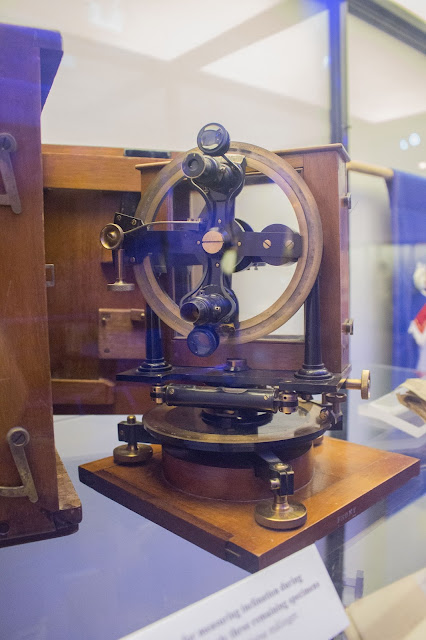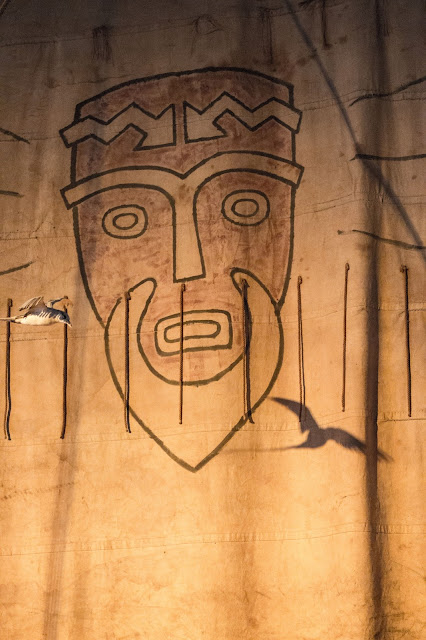During the war, you also had to dodge these nasty buggers:
 |
| This didn't just wash up on shore - it is on display outside the Kon Tiki museum |
There's an old naval expression that says EVERY ship is a mine detector - some only do it once.
Wandering down Oslofjord you will come to some narrows. If you're in charge of navigation - stay in the east channel around the island. When southbound, take the island to starboard. This is really really important.
These narrows were not always as calm as they appear today. Here's the first clue.
 |
| Oil, slowly bubbling to the surface. |
Look for Drobak on the map below.
From a military standpoint, Drobak is the perfect place to site a fort. All the way back in 1644 the Norwegians figured that out and built Fort Oscarrborg on the island in the middle. In a clever move they filled in the west side of the waterway with rocks that ended 3 feet below the surface. This wouldn't hamper small fishing boats and would force larger ships (at least the ones that knew about the hidden obstruction) to take the channel to the east.
This is Fort Oscarrborg today:
 |
| Note the display of old muzzle loader cannons |
 |
| Observation tower |
By the end of the 19th century every one knew that stone fortresses were now obsolete. The Norwegians decided to upgrade the defenses anyway and proceeded to install 3 German 6 inch guns.
6" guns aren't all that big, but consider that by the time a ship came into range - it was a point blank shot. Then, in a very clever move, they installed 3 torpedo tubes on the back side of the island (and kept their mouths shut). Those torpedo tubes were one of the few things that WW II German intelligence knew nothing about. Ironically they were armed with German torpedoes the Norwegians had bought in 1900.
Sure enough, on April 9th, 1940, a German Kriegsmarine flotilla, lead by the heavy cruiser Blucher,
sailed up the fjord in a two prong pincer movement to capture Oslo (the other prong came over land to attack Oslo from the east). They knew, of course, all about the 3 6" guns they'd be facing (hell, the Germans had sold them the guns). The Germans were expecting a ferocious firefight. This was their first surprise - they didn't get one. The Norwegians got off a few shots, but nothing like what the Germans were expecting. For those old guns to be effective it takes a large group of highly trained, well rehearsed gun crews in peak physical condition to bring the guns to life. The Norwegians had siphoned off most of the soldiers of the fort for duty elsewhere. This is where the story takes an unexpected twist. All the old, retired guys in Droback put down their beers and said "Bullshit, we're not gonna let the damn krauts just sail up the fjord. Let's do something". So they did. They drove over to the high school and rounded up all the boys that hadn't been drafted. Anyone who has ever been around fired up old guys and teenage boys will recognize that this could be a very dangerous mix. And indeed it was. Never screw with an old guy. We know all the tricks and we have less to lose.
The geezer garrison got off a few shots with the 6" guns but failed to score any crippling blows. The Norwegians really weren't expecting to stop them so easily. After all, they were facing a massive array of naval guns.
Then the German ships rounded the corner and fell into a trap they weren't expecting. The Norwegians nailed them with not one, but two of the, by then, 40 year old torpedoes.
 |
blucher on
fire By Riksarkivet (National Archives of Norway) from Oslo, Norway -
Senkingen av Blücher, No restrictions,
https://commons.wikimedia.org/w/index.php?curid=44299028
|
The German torpedoes did an excellent job of setting the German warship on fire. Eventually the fires spread to the powder magazine and the Blucher (a brand spanking new ship) blew up and sank (with the loss of 1,000 men).
So did this heroic action stop the invasion of Oslo? Of course not. But it did delay the Germans by a full day - which was just enough time for the Norwegian government and royal family to escape to London and set up shop. As you would expect, the Germans were mad as hell. The very next day the Luftwaffe flew over and bombed the hell out of the fort (killing and injuring no one).
So how did a 40 year old torpedo managed to sink a modern steel ship?
Quite easily as it turns out. They may have been 40 years old, but they were well maintained and it was a terrifically well designed torpedo. These torpedoes were so good that they didn't get taken out of service until 1993!
After the Blucher sank, it sat undisturbed on the bottom of the narrows (210 feet down) until 1991 when the oil leaks reached 11 gallons per day and the Norwegians decided it was becoming a threat to the environment. They sent down salvage divers and drilled holes in all the fuel tanks they could reach (133 tanks) and pumped out 1,000 tons of remaining fuel (which they promptly filtered and sold). Unfortunately, the Blucher had 180 fuel tanks and so it continues to slowly leak oil today.
We were on the way to Alesund, Norway when I spotted a bird I haven't seen in a while.
Alesund is a sea port that is known for it's Art Nouveau architecture. Simply put - the town is drop dead gorgeous.
If you're wondering how I got the aerial photos above, I walked up the "Fjellstua Viewpoint" winding staircase to the visitor center at the top of the hill:
 |
| 486 steps, but with a Norwegian sense of whimsy they only put numbers on random steps (63, 187, etc.) |
 |
| One of the cool things about the staircase (besides all the wheezing tourists around you and the fabulous view) is the railing. It's fashioned out of wrought iron bars. |
Alesund isn't a big place (45,000 lucky inhabitants) but it has a sad history. In 1904 they had Mrs. O'Leary's cow on display at an exhibition. The next thing you know - the entire town burned to the ground. Only one poor guy died, but 10,000 were left homeless (OK, I made up the part about the cow, but as we all know - cows are extremely dangerous and if they didn't taste so good should be eradicated from earth).
Norwegians aren't stupid, so when they rebuilt the town they used bricks instead of wood.
Estonia was quite a pleasant surprise. Tallinn, where a third of all Estonians live, decided to bag the traditional city fountain and instead sponsor a balloon.
Tallinn was founded in 1248, but since this is Europe, actually dates back 5,000 years (Oh Lord, not again...that sound you just heard was me bonking myself in the head). Estonia is one of those incredibly neat places where what you see is more or less the exact opposite of what they're really all about. Here's what you see
This is called the Open Air Museum. It's a replica of an 18th century village. At first glance it seems quite primitive. The closer you look, however, the more clever you discover it really is. Take the roof:
Also thick enough to provide excellent insulation.
Biking over to Tallinn's old town you will find one of Europe's best preserved medieval cities. In fact, it's now a UNESCO world heritage site.
That being said, it's a little on the creepy side.
So, after visiting a buncha old stuff, it came as a surprise to find out what Estonia is all about today. Here's a hint:
As it turns out, Estonia is considered the "silicon valley" of Europe. Tallinn is the birthplace of Skype.
In 2011 Micro Soft paid $8.5 B to acquire Skype. It has been estimated that there are at least 1,000,000,000 world-wide users of Skype (myself included). Skype started in Tallinn and currently almost half of the division still live here. Tallinn has more start ups per person than all of Europe. There's so much software talent in Tallinn that it was chosen to be home to NATO Cyber Defense Center of Excellence. Not bad for a city of less than 1/2 million inhabitants!
Next up - Mother Russia.
 |
| Thick enough to keep the interior dry |
 |
| Where there's grain - there's rodents. See picture below for explanation of this large hole. |
 |
| This stone grain grinder is more sophisticated than it first appears. Just pour the grain in the hole in the center, grab the stick and give it a spin - the flour comes out the sides. |
 |
| Native American equivalent tool (rather primitive by comparison). |
 |
| Hard to tell what this is. Hint - not used for cosmic research or torturing prisoners from Russia. |
 |
| This is our cute bike tour guide perched on it - it's the village swing set. |
 |
| Our bike tour guide - flawless unaccented English, college educated, co-owner of business. |
Biking over to Tallinn's old town you will find one of Europe's best preserved medieval cities. In fact, it's now a UNESCO world heritage site.
That being said, it's a little on the creepy side.
So, after visiting a buncha old stuff, it came as a surprise to find out what Estonia is all about today. Here's a hint:
As it turns out, Estonia is considered the "silicon valley" of Europe. Tallinn is the birthplace of Skype.
In 2011 Micro Soft paid $8.5 B to acquire Skype. It has been estimated that there are at least 1,000,000,000 world-wide users of Skype (myself included). Skype started in Tallinn and currently almost half of the division still live here. Tallinn has more start ups per person than all of Europe. There's so much software talent in Tallinn that it was chosen to be home to NATO Cyber Defense Center of Excellence. Not bad for a city of less than 1/2 million inhabitants!
Next up - Mother Russia.





































































































